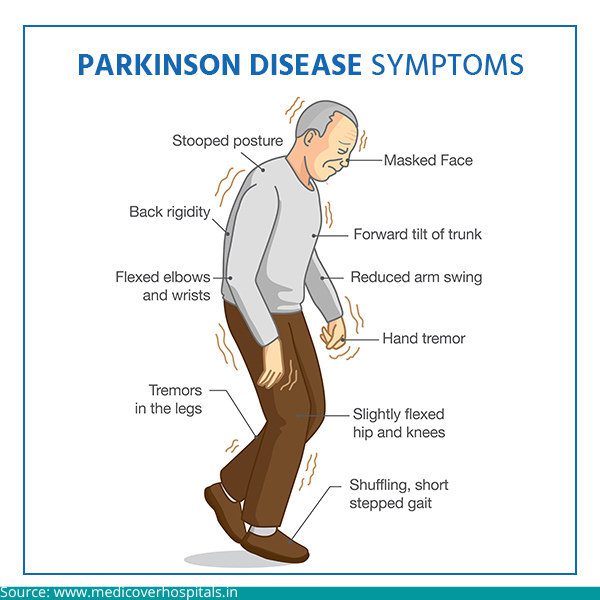Parkinson’s disease is a condition in which the brain cells that produce the chemical dopamine responsible for movement and coordination begin to break down and die. Numerous signs and symptoms of Parkinson’s disease include tremors, facial grimacing, rigid muscles, slow movement, joint stiffness, and difficulty with balance and coordination.
You might also exhibit other uncontrollable movements, such as head bobbing, swaying, or fidgeting. These are symptoms of a disorder called dyskinesia. Dyskinesia refers to problems with muscle movement. This can include uncontrolled or involuntary muscle movements as well as muscle stiffness. It’s important for those experiencing such symptoms to consult with an experienced neurosurgeon who can provide specialized care and management strategies tailored to their needs.
People who use levodopa to manage Parkinson’s disease can develop dyskinesia, an uncontrolled involuntary movement, says Dr. Gurneet Singh Sawhney, a prominent neurosurgeon in India.
Read on to learn some tips to manage this condition called dyskinesia.
Ready to take charge of your dyskinesia in Parkinson’s? Book your consultation and reclaim control of your life today!

There are a few things that may help to manage dyskinesia:
1. Adjust your medications

If you are taking medication for your Parkinson’s, dyskinesia may be a side effect. Higher doses of levodopa are more likely to result in adverse effects like dyskinesia.
Dr. Gurneet Singh Sawhney, often regarded as the best neurosurgeon in Mumbai, says that taking more than 600 mg per day over the long term is linked to a higher incidence of dyskinesia.
Finding the lowest dose at which your symptoms can still be controlled is crucial. In order to do this, Dr. Gurneet Singh Sawhney starts his patients on a smaller dosage and then gradually increases them as necessary.Talk to your doctor about adjusting your dose or changing to a different medication.
2. Include additional medication
Your doctor may be able to lower your levodopa dosage by recommending a medication known as a dopamine agonist, which may help to lessen the effects of dyskinesia. According to the APDA (American Parkinson Disease Association), dopamine agonists replicate the effects of naturally occurring dopamine (levodopa, on the other hand, converts into dopamine in your brain).
Dr. Gurneet Singh Sawhney, who has conducted many a Parkinson’s surgery in Mumbai, says that Amantadine may be added to your treatment plan to help with dyskinesia symptoms. Some medical professionals employ botulinum toxin or Botox injections to treat dyskinesias if it is affecting the neck, face, and limbs.
Clinical trials are ongoing for a number of additional medications to treat dyskinesias. Potential treatments for tardive dyskinesia include melatonin and estrogen, which modify dopamine-controlled behavior and shield cells from harm caused by prolonged antipsychotic medication use.
3. Deep brain stimulation

Deep brain stimulation is a surgery that can help to reduce dyskinesia and control tremors, fidgeting, stiffness, and difficulties walking. Dyskinesia can also be prevented with DBS.
Levodopa dosage may be reduced thanks to DBS, which may help with the symptoms of dyskinesia. During DBS, Dr. Gurneet Singh Sawhney will insert a tiny gadget comparable to a pacemaker into your brain. Electrical signals are sent from this gadget to the areas of your brain that manage movement. It stops the aberrant nerve impulses that lead to dyskinesia and the signs of Parkinson’s disease.
4. Aerobic exercises
People often experience a loss of energy early on in the progression of Parkinson’s disease, according to the renowned neurosurgeon and dyskinesia specialist in Mumbai, Dr. Gurneet Singh Sawhney. It can be an unpleasant feeling, you could feel worn out, and routine things might seem physically taxing.
Taking levodopa will help you regain some of that pep, and you should use that extra energy to concentrate on aerobic activity.
Physical therapy and exercise can help to improve your overall movement and reduce dyskinesia. Tai chi and yoga are 2 types of exercise that may be particularly helpful.
5. Manage your stress
Learning to successfully handle stress may help you lessen the symptoms of dyskinesia since it can have a propensity to get worse during stressful times. Stress can also turn into frustration and anger, prompting adrenaline to be released, which will further worsen dyskinesia. Plan your day schedule carefully, leaving plenty of time for each activity.
Think about engaging in deep breathing exercises, meditation, listening to pleasant music, or even just spending quality time with your loved ones. If a loved one has this condition, please ensure that you display patience and a calm composure when speaking to the patient.
6. Dietary changes
Some people find that certain lifestyle changes can help to reduce dyskinesia. Cutting out caffeine, alcohol, and tobacco may help. Eating a healthy diet and getting enough sleep can also be beneficial.
Making these lifestyle changes can be difficult, but they may help you to manage your dyskinesia better. Please speak with Dr. Gurneet Singh Sawhney, a well known neurosurgeon in Mulund, Mumbai about which changes may be right for you. He is among the preferred neurosurgeons for people seeking dyskinesia treatment in Mumbai.
Take the first step towards managing your dyskinesia with confidence. Schedule a consultation with Dr. Gurneet Singh Sawhney, and start your journey to a better health now
Conclusion

Living with dyskinesia is easier for many people than coping with Parkinson’s symptoms. Others, though, may find it painful and disruptive to their social lives as uncontrolled and involuntary movement, or dyskinesia, can fluctuate in severity and resemble fidgeting or swaying.
These symptoms can cause immeasurable discomfort to the person with the disorder, and it is distressing for the patient’s family and friends to watch their loved ones’ discomfort. The objective is to find a treatment plan that reduces your adverse effects and enables you to live your life to the optimum despite having Parkinson’s disease.
If you or a loved one is having trouble managing dyskinesia, please do not hesitate to visit Dr. Gurneet Singh Sawhney, a top-notch neurosurgeon in India, for safe and effective treatment options.
FAQ
1. What are the signs that Parkinson’s is getting worse?
Signs that Parkinson’s may be progressing include increased difficulty with movement, such as walking or balancing, worsening tremors or stiffness, and changes in speech or cognitive function.
2. what is the difference between parkinson’s and dyskinesia?
Parkinson’s is a neurodegenerative disorder causing tremors and stiffness. Dyskinesia is medication-induced involuntary movements.
3. Are there specific medications that can worsen dyskinesia?
Yes, medications like levodopa and dopamine agonists used to treat Parkinson’s can worsen dyskinesia as a side effect.
